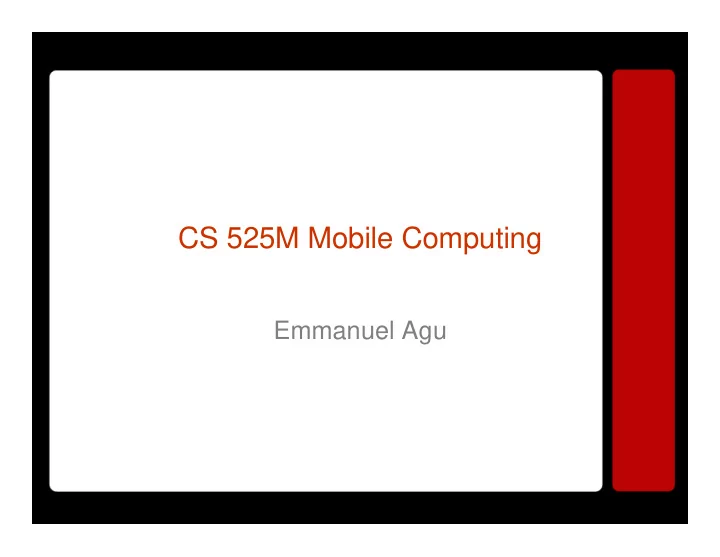

CS 525M Mobile Computing Emmanuel Agu
Database Management in Mobile Environments • Last week, talked about applications: – wireless web, messaging, MPEG, application-aware adaptation • Today focus on data management issues • First, I’ll motivate problem and recurrent themes, then 3 student presentations • Summarize main ideas from paper: • Imielinksi and B. R. Badrinath “Mobile Computing: Challenges in Data Management," Communications of the ACM, October 1994” • Imielinski and Badrinath: – pioneers in mobile data research – Dataman group at Rutgers – 10-year best VLDB paper award
Data Management • Envisioned user computing scenario: nomadic and mobile computing • Actual mobility management will be a network level issue. E.g. mobile IP • However, data-centric issues exist • Mobile users will be both producers and consumers of data • Some data will be location-dependent or time-sensitive: need update as user location changes • Two main data access options: – Server broadcasts information (push) – Users query for specific information (pull)
Data Management • Broadcast (push): – Air charged with “hot” (frequently requested) information – User PDA acquires, filters and presents required info – Issues: optimal broadcast patterns (metrics: latency, real time guarantees, etc), caching at client • Searching (pull): – Small user groups share information e.g. salesmen – Issues: partitioning database, location-dependent queries • Hybrid approaches: some push, some pull?
Data Management • Mobility-related definitions: – Location management: moving users (e.g. handoff in cellular) – Configuration management: mobility of resources • Location management paradigms: searching Vs. informing: – A wants to locate B – Should A search entire network for B? – Should A look only in predefined locations (e.g. using B’s statistics and movement history)? – Should B inform A anybody of his or her moves?
Data Management • Mobile user may be very far from server • Servers may also move far away • This leads to varying spatial distribution of clients • Dynamic data replication required • Basic question: should the data “follow” the user (static Vs. mobile) • Other issues: disconnection, reintegration, consistency • Bandwidth constraints: wireless links cannot sustain large amount of update messages • Energy constraints: wireless terminals need to sleep to conserve energy, wake up at pre-defined times • Today’s papers: – Broadcast disk: seminal work, multiple disk abstraction – Database survey: nice overview with valuable pointers – Data on Air: Indexing and structured data dissemination • Interesting aside: Digital Fountain, company using broadcast disks (courtesy of Mark Figura)
Projects • At this point, should be thinking of a few potential areas • Suggestion on how to proceed: – Start with 1 paper in chosen section, which interests you – Make sure you understand the issues and specific problem being solved – Look at references, especially “Related Work” section – Chase up and skim papers (abstract, intro, results) in related work section • Start a bibliography • Take note of experimental tools – Resources to search: • ACM digital library: www.acm.org/dl • Citeseer: http://citeseer.nj.nec.com/cs • IEEE Xplor: ieeexplore.ieee.org/ – Good indicator: Can I reproduce paper experimental setup and results?
Recommend
More recommend